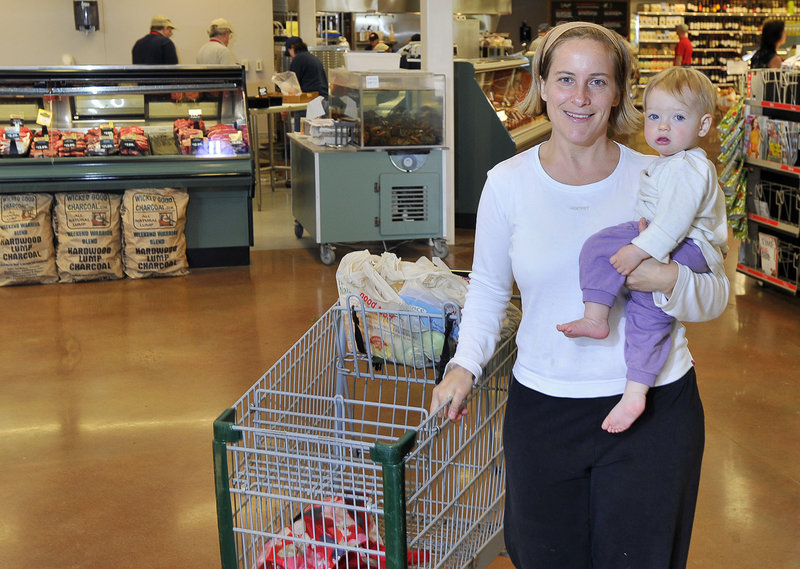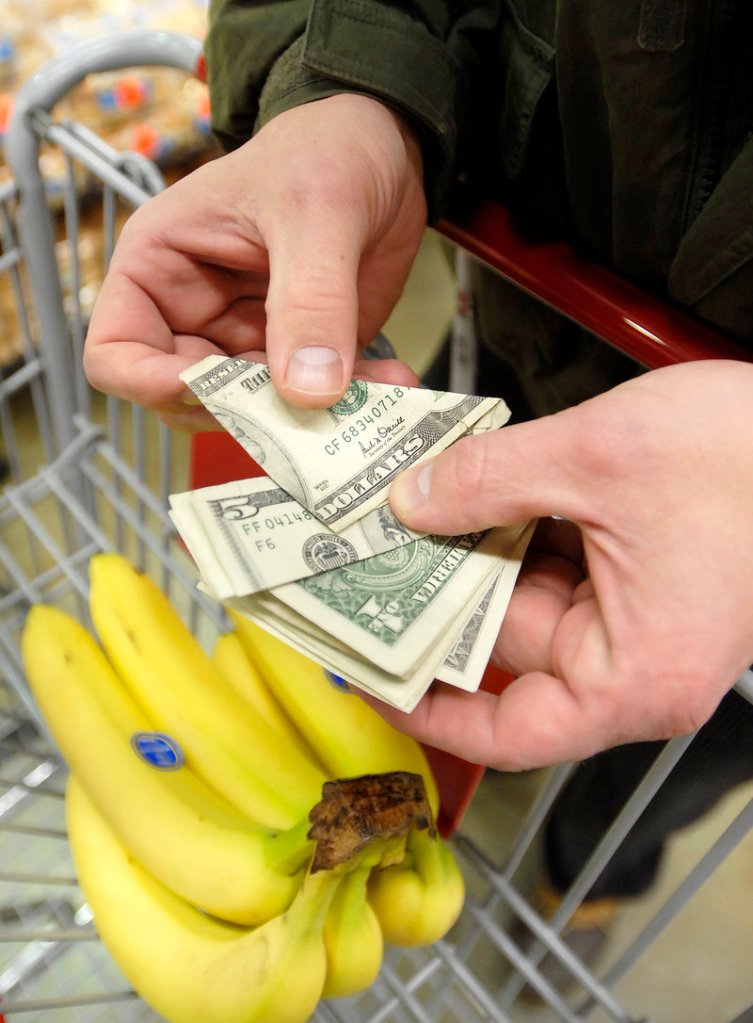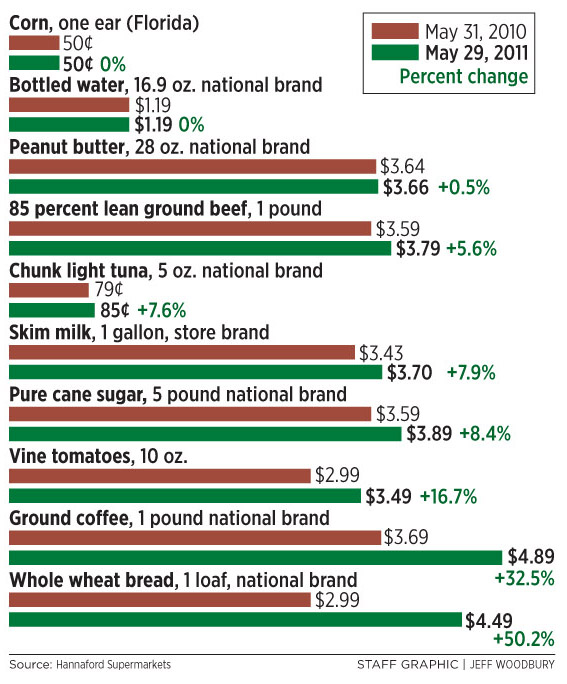FREEPORT – Jody Bennett said about the only food she buys at a supermarket these days is coffee.
The Freeport resident is raising her own beef and growing her own vegetables, instead of purchasing such items in the store.
“I’ve actually started canning,” said Bennett.
Bennett, who stopped for coffee at the newly expanded Bow Street Market in Freeport on Friday, is among those shoppers who are changing their buying habits to cope with a surge in grocery prices.
“I might buy three bananas instead of a whole bunch,” said Sue Hughes of North Yarmouth.
Gone are the days of deflation, when prices for some grocery items actually went down, said Adam Nappi, owner of Bow Street Market.
“Pricing is tricky,” said Nappi.
After two years of the lowest food inflation rates since the 1960s, food prices are headed up again. The U.S. Department of Agriculture reported that nationally, overall food prices jumped 3.9 percent from April 2010 to last month.
Coffee prices have soared nearly 14 percent in the past year. Beef and pork prices shot up 10.4 percent. Dairy prices are up 6.3 percent, eggs up 4.8 percent and fresh vegetables up 4.5 percent.
Those increases make other food categories look like a bargain. Poultry is up a mere 2.3 percent, fresh fruit up 1.6 percent, and carbonated drink prices were up less than a percent.
Rising food costs have triggered a flood of price increase announcements by food companies. McDonald’s, Hershey’s and Starbucks have all announced price hikes in recent weeks. Nestle Waters North America Inc., owner of Maine-based Poland Spring, has joined the parade, raising prices 10 percent last month, its first increase in a decade. Nestle cited the rising cost of plastic.
The government is now projecting grocery store food prices will rise 3.5 percent to 4.5 percent in 2011, while restaurant food will rise 3 percent to 5 percent.
Bad weather, rising global demand and political turmoil in the Middle East that has triggered fuel increases are to blame, say economists.
“There is a shift particularly in developing countries toward an American-European diet, which has pulled up the cost of things like beef,” said Charles Colgan, an economist at the Maine Center for Business and Economic Research at the University of Southern Maine.
Colgan said some argue that ethanol subsidies have pushed up the price of corn, which in turn raises the cost of corn-fed beef and pork and foods made with corn syrup and other corn products.
Meanwhile, heat and drought heavily damaged the wheat crop in Russia, France and Australia. Colgan said it appears bad weather is increasing.
“There are a lot more factors pushing prices up than pushing prices down, ” said Colgan.
Restaurants, bakeries and food pantries say they are scrambling to keep up.
Geoff Titherington, owner of the Bonanza Steakhouse in Sanford, said he was able to keep prices the same for the past five years, but finally had to increase many entrees by a dollar after the chain’s meat packers raised their own prices last month. He said beef producers are reducing their herds due to the high price of corn feed. In the short term, that has increased the supply of beef and helped keep prices a bit lower, Titherington said.
“The downside is that those producers are not raising many calves, and that will cause prices to climb even higher in the future,” he said.
Harding Lee Smith, chef and owner of The Corner Room, The Front Room and The Grill Room restaurants in Portland, said he has raised prices here and there but it’s a balancing act with his customers’ incomes.
“They haven’t gone up,” said Smith.
Dan Beck, an owner of Moody’s Diner in Waldoboro, said he raised menu prices, some by up to 5 percent, last summer but is afraid to do it again this year.
“Because if you don’t have customers, you don’t make anything,” he said.
Instead, the staff is trying to operate more efficiently and cut down on waste.
“When the kitchen prep needs to make up mashed potatoes, it’s now, ‘Let’s just make enough to get us through,’ instead of over-anticipating,” said Beck.
Mary Allen Lindemann, co-owner of Coffee By Design, a Portland specialty coffee producer, said she has been agonizing over the yet-to-be-determined price increases she will be instituting sometime next month.
Prices from coffee producers are at an all-time high, driven by factors such as rising demand, bad weather in high production countries like Colombia and the disappearance of specialty coffee farms.
Grocery stores say they have seen several shifts in consumer behavior due to rising prices.
Michael Norton, spokesman for Hannaford Supermarkets, said registered users on its website more than tripled to 57,300 in the last three months, as shoppers searched for online coupons and items on sale. The number of shoppers requesting weekly fliers by email has risen from 20,000 to just under 50,000 since January 2010.
Norton said despite the highest coffee prices in two decades, sales of premium coffee are up 6.8 percent, a sign that people are bypassing the coffee shop.
“People are buying with us and preparing at home,” said Norton.
Good Shepherd Food-Bank in Portland, which distributes enough food for 25,000 meals a day, is feeling the pinch from all sides, said Rick Small, president and chief executive officer. He said the need is about double that number.
Small said the organization’s rising fuel prices have driven up delivery costs to local food pantries and shelters, at the same time that food costs have taken off. Meanwhile, donations are about even with last year. The food bank, which buys about 30 percent of the food it distributes, has seen the cost of a case of tuna rise 25 percent, peanut butter 26 percent, whole kernel corn 33 percent, fruit cocktail 86 percent and beef patties 90 percent.
Good Shepherd is looking for new sources of cheap food. Last year, the agency started contracting with local farmers to avoid the transportation costs of food grown in other parts of the country. The farmers grew 355,000 pounds of fresh produce out of 12 million pounds of food distributed by the food bank last year. Small said the organization is now looking for ways to process the food in Maine rather than shipping it out of state for processing, then trucking it back.
Colgan, the USM economist, said the growing availability of local produce is a silver lining in the otherwise grim food-price picture.
“Farmers markets and local produce will probably become very competitive over the next three to five months,” said Colgan.
He said most consumers have yet to go as far as they can to buy as cheaply as possible.
“Most people don’t shop the cheapest every time or go after coupons,” he said.
Caroline Loder of Brunswick, newly arrived from Germany, said she is reeling from the cost of feeding her family of five an organic vegetarian diet. She said in Germany she was spending $100 a week on food, but she is paying $300 a week in Maine.
She said now she is shopping much more carefully and buying only items her family will use up.
“I have a much worse feeling about tossing” out, Loder said.
Staff Writer Beth Quimby can be contacted at 791-6363 or at:
bquimby@pressherald.com
Send questions/comments to the editors.






Comments are no longer available on this story